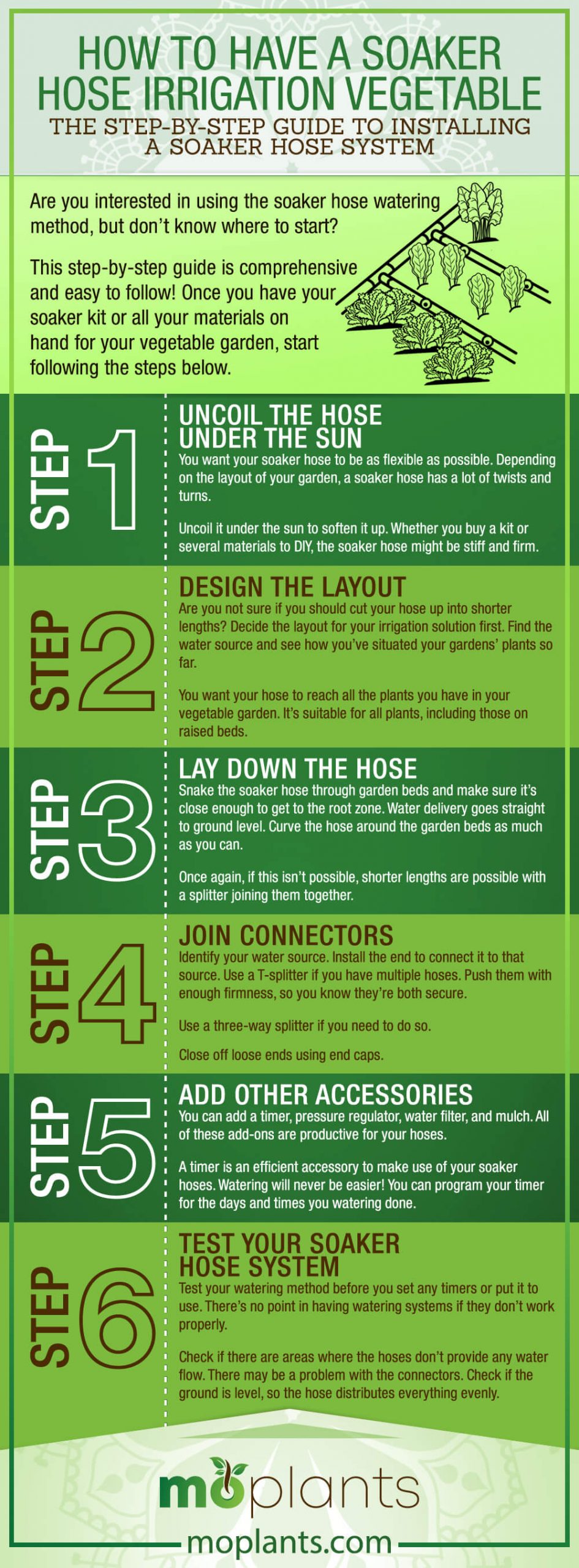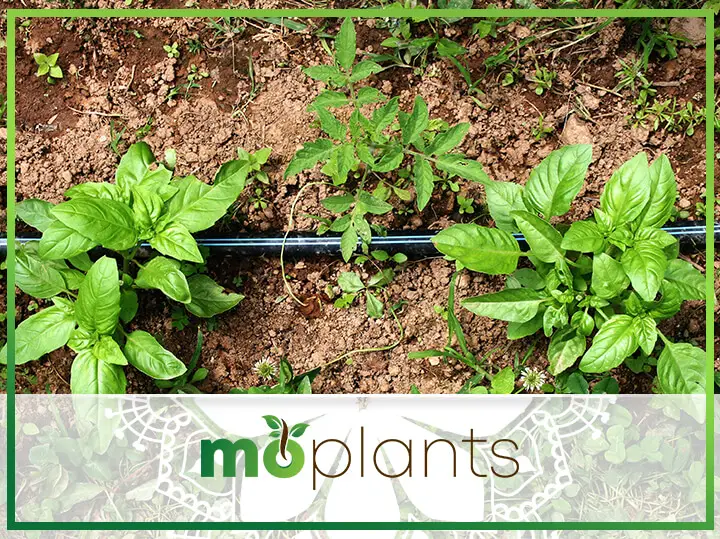A soaker hose irrigation in your vegetable garden is ideal.
It saves you a lot of time, plus you maximize every bit of resources used. If you want the amount of water you use to give everything you need in return, read this guide.
Soaker hose irrigation is easy enough to do. Follow the following steps and read all the benefits you reap from it after you do so!
What You’ll Need:
There are two methods to install a soaker hose. For one, you can use a soaker hose kit. Another way is to DIY your system. To DIY, you need the following:
- The hose
- Plumbing pipes, if needed
- Hose couplers
- Soaker hose end cap, if needed
- Three-way splitter, if needed
- T-splitter, if needed
- Sharp scissors or shears, if needed
- The pressure regulator (optional)
- Water filter (optional)
- Garden staples (optional)
The Step-by-Step Guide to Installing a Soaker Hose System
Are you interested in using the soaker hose watering method, but don’t know where to start?
This step-by-step guide is comprehensive and easy to follow! Once you have your soaker kit or all your materials on hand for your vegetable garden, start following the steps below.
Step 1: Uncoil the Hose Under the Sun
You want your soaker hose to be as flexible as possible. Depending on the layout of your garden, a soaker hose has a lot of twists and turns.
Uncoil it under the sun to soften it up. Whether you buy a kit or several materials to DIY, the soaker hose might be stiff and firm.
Leave it under the sun for an hour or two. After you deem it flexible enough, you can decide whether you want to cut the soaker hose into shorter lengths. It’s easier to do it after the hose is soft enough!
Step 2: Design the Layout
Are you not sure if you should cut your hose up into shorter lengths? Decide the layout for your irrigation solution first. Find the water source and see how you’ve situated your gardens’ plants so far.
You want your hose to reach all the plants you have in your vegetable garden. It’s suitable for all plants, including those on raised beds.
Ideally, you can curve the entire length of your hose on level ground. You’ll pass through all rows of plants.
However, if you have a layout that no hoses can reach, then, you can shorten your hose. Use a pair of sharp scissors or shears to cut them to your needed length.
Use a T-splitter to join the lengths together. Keep in mind that you need to connect them to your water source.
Step 3: Lay Down the Hose
Snake the soaker hose through garden beds and make sure it’s close enough to get to the root zone. Water delivery goes straight to ground level. Curve the hose around the garden beds as much as you can.
Once again, if this isn’t possible, shorter lengths are possible with a splitter joining them together.
There may be times when you can’t seem to hold down your hose in one place. In this situation, use garden staples. They can secure your hoses properly!
Step 4: Join Connectors
Identify your water source. Install the end to connect it to that source. Use a T-splitter if you have multiple hoses. Push them with enough firmness, so you know they’re both secure.
Use a three-way splitter if you need to do so.
Close off loose ends using end caps.
Step 5: Add Other Accessories
You’re all done! However, there may be other products you may want to incorporate.
You can add a timer, pressure regulator, water filter, and mulch. All of these add-ons are productive for your hoses.
A timer is an efficient accessory to make use of your soaker hoses. Watering will never be easier! You can program your timer for the days and times you watering done.
Decide how long it takes to water the entire area and when you want to do it.
Second, a pressure regulator can also work wonders. Water pressure is best for soaker hoses when it’s low. Regulate your water flow using a regulator. Choose a type that you can adjust to your liking.
Third, you can add a filter. If you live near an area with hard water, a filter may be a good investment. Hard water means it has mineral deposits, which you don’t want near your plants when gardening!
Finally, you can opt to add mulch. A soaker hose works just as well on the soil surface and underneath a layer of mulch.
Mulch benefits gardens and gardeners in different ways.
It provides enough nutrients to whatever you plant and reduces evaporation. You insulate the roots and suppress weeds, too. A layer of organic and inorganic mulch can up your gardening experience.
Step 6: Test Your Soaker Hose System
Test your watering method before you set any timers or put it to use. There’s no point in having watering systems if they don’t work properly.
Check if there are areas where the hoses don’t provide any water flow. There may be a problem with the connectors. Check if the ground is level, so the hose distributes everything evenly.
Shorten hoses as needed. Sometimes, an uneven distribution may mean you need to shorten your hoses more.
Infographic

What Are Soaker Hoses?
Soaker hoses live up to their name!
Soaker hoses ooze water into the soil, which results in deeper, better watering. The water reaches the roots immediately, unlike other watering methods.
A soaker hose differs from garden hoses, as its tiny pores deliver water into the soil.
They’re flexible and porous. Recycled rubber usually makes up most of the soaker hoses, so it’s environmentally-friendly, too.
What Is A Drip Irrigation System?
Many new gardeners can confuse drip irrigation systems with soaker hose systems. Drip irrigation is another type of watering method. It’s similar to utilizing soaker hoses, with a few key differences.
Let’s get into the similarities of these two drip systems first. Like soaker hoses, a drip irrigation system delivers precious H2O straight to the roots.
However, it differs when we call material into question. Drip irrigation uses plastic tubing and delivers water using tiny holes.
These tiny holes emit water straight to the soil. These drip lines go deep into the soil with several drippers.
In comparison, soaker hoses have porous material that leaks water into the soil.
Drip irrigation is a good alternative if you don’t want to use soaker hoses.
You save just as much water! It won’t saturate the soil and you won’t soak foliage that results in powdery mildew and fungal diseases.
It’s also low-pressure and results in consistent, better yields for gardeners!
Why Use a Soaker Hose System?
So, why use a soaker hose in the first place? Isn’t it more convenient to use sprinklers or just hand water every area in your vegetable garden?
Soaker hoses come with several benefits. Let’s discuss them below.
Save Water
Using a soaker hose saves a lot of water.
When you use a sprinkler system or hand water all your plants, you use more water than necessary. Both systems don’t deliver water directly to the roots, which is where the plants need them most.
Instead of delivering water straight to the roots, sprinklers and hand watering put water on leaves. Most of the water runs off or becomes lost to evaporation.
With a soaker hose, you use all water efficiently. Nothing turns to waste! You use less water for your garden, but all the water goes to where you need it. Plus, it just leaks the right amount.
Gardeners no longer saturate their soil or the plant roots.
Save Time
Sometimes, we’re all too busy to garden. We get too caught up with life! Family, work, studies, and our social lives keep getting in the way.
Neglecting your garden ends up in rotted plants and weed infestation.
With this irrigation method, you can save time and give your garden everything it needs!
If there’s one thing this irrigation can offer, it’s stress-free gardening. You don’t have to set aside time every week to attend to your plants anymore.
You can just set aside a day to install a brand new watering system, and you’re good to go! Turn the water on when you need to use it, set a timer, and let it run its course.
You don’t have to lug around a garden hose or use your sprinklers anymore. You can have a worry-free gardening experience and enough time for your personal life, too.
Save Plants From Weeds
Outsmart all weeds trying to take over your garden areas! With a soaker hose watering system, you deprive your weeds of any care they need to thrive.
When you use sprinklers or watering cans, the water doesn’t go straight to the crops’ roots.
Using both tools doesn’t just mean your waste a lot of your water usage, you also take care of your weeds. They end up thriving and spreading out to all areas of your home garden.
With soaker hoses, you don’t even give weeds a chance to sprout.
Once you install soaker hoses, you can also add mulch to your garden. Either organic or inorganic mulch will do.
Organic mulch involves straw, grass clippings, leaves, shredded bark, wood chips, and more. Inorganic mulch includes landscape fabric or plastic.
One layer is enough to suppress weeds from growing in your garden! It blocks out sunlight. With the added irrigation methods like a soaker hose system, you drive away weeds from the soil.
Save Foliage From Moisture
Fungal diseases form when plants receive too much moisture. Remember what we said about water not going straight to the crops’ roots? They end up on the foliage, which isn’t a good thing!
Fungal diseases are serious. It can end up killing your plants or cause them stress.
You can identify fungal diseases easily! Just look for powdery white spots on your plants – not just on their leaves. Check the stems as well.
After diseases become serious, leaves can turn yellow. Leaves twist and become disfigured. They can also dry up and fall out.
If you have any plant that shows signs of fungal diseases and mildew, don’t worry.
You can still save them! Prune affected areas and move your crops to sunnier spots. Throw away all pruned, infected leaves or stems. Don’t compost them.
Install your irrigation with drip hoses after! This irrigation system helps prevent pesky fungal diseases.
There you have it. Using soaker hoses gives gardeners multiple benefits. You save water and time, plus you can prevent diseases and weeds.
Switching from traditional watering methods to soaker hoses is worth it! You dedicate enough time to install soaker hoses for your vegetable garden, and you’re good to go.
Conclusion
We hope you enjoyed this article! What did you think?
A soaker hose is one of the best watering methods for your garden.
You can buy a soaker kit or do it yourself. You’re likely to finish it in a matter of hours. You end up with a healthy garden and more time to yourself.
Are you using a soaker hose for your garden? Are you planning to install one? Let us know how it goes! Share your opinions, thoughts, and experiences in the comments below.


